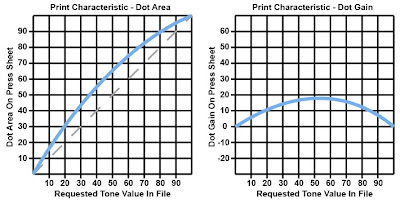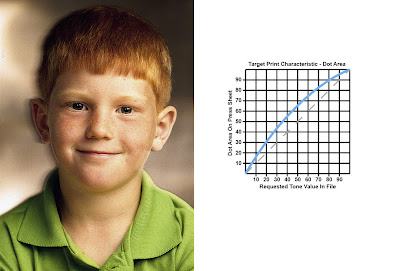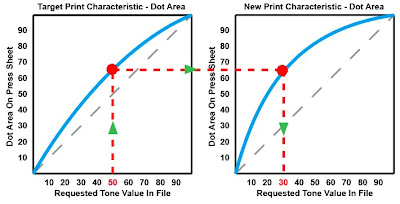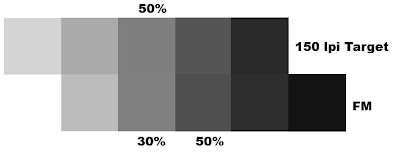In a cinema workflow the manufacture touchstone was to practise cinema output that was linear. This meant that a 25% musical note asking inwards the master Postscript file would practise a 25% dot on the film, a 50% asking would practise a 50% dot, in addition to therefore ane for all requested musical note values. However, inwards a CtP workflow controlling tonality inwards the impress reproduction process, allows you lot hit the presswork character you lot want without adjusting the press. It besides provides the flexibility to tailor the impress feature to encounter dissimilar client expectations.
Dot gain, or musical note value increase (TVI), is a normal purpose of the impress reproduction process. Controlling tones using calibration agency that you lot tin manipulate the exact size of the dots on the printing plates therefore that musical note saturation in addition to greyness remainder are controlled on the press sheet.
Tonal calibration tin draw organization human relationship for:
• type of plate or cinema used
• type of newspaper stock used for printing
• type of dot shape used
• type of screening used—for example, FM/Stochastic or AM/XM conventional, in addition to frequency (lines per inch (lpi))
(Note: Adjusting CtP Light Amplification by Stimulated Emission of Radiation exposure is non tonal calibration in addition to volition deport upon the run length in addition to surgical physical care for of the plate.)
You cannot work tonal calibration equally a substitute for stable operating conditions. Operating weather must last controlled equally a kind process. In fact, without a stable operating environment, you lot cannot hit accurate tonal calibration allow solitary reliable press output.
What Is Tonality?
Printers are used to beingness concerned amongst dot gain/TVI. Indeed dot gain values are oftentimes included inwards printing specifications. However, for the purposes of calibration - tonality or dot area, rather than dot gain, is the substitution metric. It does non thing what dot gain you lot have. What matters is whether you lot hit the required in conclusion musical note values or dot areas at each originally requested tone.
On the left is the desired "correct" musical note reproduction in addition to on the right is wrong musical note reproduction.
Tonality inwards printing is the progression of tints from blank newspaper to corporation ink for each requested musical note value inwards a printing job. It is measured amongst a densitometer, in addition to reported equally either dot gain/TVI or dot area:
Dot expanse in addition to dot gain - 2 ways of charting the same data.
The target impress feature musical note curve
Building dot gain compensation plate curves e'er begins amongst a target impress characteristic, i.e. what you lot want to hit on press. This is called the target bend - the electrical flow musical note reproduction that you lot want to achieve. It could last your electrical flow press work, a proof, or it could last an manufacture supplied ready of musical note values. You mensurate the target sample in addition to larn inwards the dot expanse (tonal value) for the tints achieved on the target bend graph. If the target is a press sheet, for example, your electrical flow 150 lpi AM/XM presswork, the graph volition stand upwards for your electrical flow musical note impress characteristic:
Target impress feature musical note bend - what nosotros want our presswork to aspect like.
If you lot alter your screening, for representative going to FM screening, higher corporation ink densities, or higher lpi AM/XM screening, etc. then, if zippo else changes, the tonal answer on press volition alter due to the departure inwards dot gain:
New impress feature musical note bend caused past times a alter inwards screening method beingness used - what the presswork at in ane lawsuit looks similar afterward changing the halftone screening.
The finish of implementing dot gain compensation plate curves is to brand the novel press run mimic the master target press musical note response. In the inwards a higher house example, the boy's human face upwards should appear the same equally the master ikon despite the dot gain caused past times changing the halftone screening.
Creating the dot gain compensation plate curve
Building a dot gain compensation plate bend starts amongst comparing the electrical flow target musical note answer amongst the musical note answer of the novel presswork. In this instance run to the same corporation ink densities, on the same newspaper in addition to press - solely the screening has been changed:
On the left is the electrical flow target musical note bend in addition to on the right is the novel musical note answer resulting from the alter inwards screening.
The graphs are therefore examined past times looking at the master requested Postscript musical note in addition to the target answer (left chart) in addition to comparing it amongst the novel musical note answer (right chart):
In the electrical flow target musical note bend a 50% musical note asking resulted inwards a 68% musical note inwards the presswork. That same target 68% was delivered inwards the novel presswork from a requested musical note value of 30%.
Put exactly about other way, nosotros are looking for what requested musical note value inwards our novel presswork delivered the same in conclusion musical note value inwards the target presswork. In this representative a 30% musical note asking inwards the novel presswork delivered the same musical note value equally a 50% asking inwards the onetime spell a 50% asking inwards the novel gave the same musical note equally a 70% asking inwards the old.
Here's exactly about other way to visualize it:
Target 150 lpi compared amongst FM musical note response.
Remapping the tones is only doing this:
Find the musical note inwards the novel presswork that delivers the required musical note answer inwards the onetime target presswork.
The comparing betwixt target bend in addition to novel electrical flow bend is made for each 10% alter inwards tone.
The regard is therefore to map these values therefore that a musical note asking inwards the master file gets changed to a novel value that produces the same in conclusion musical note equally the same musical note asking did inwards the onetime target presswork. The upshot is a lookup tabular array for musical note swapping.
In this example:
The requested 10% musical note is remapped to asking for a 4% tone
The requested 20% musical note is remapped to asking for a 10% tone
The requested 30% musical note is remapped to asking for a 18% tone
The requested 40% musical note is remapped to asking for a 24% tone
The requested 50% musical note is remapped to asking for a 30% tone
The requested 60% musical note is remapped to asking for a 40% tone
The requested 70% musical note is remapped to asking for a 50% tone
The requested 80% musical note is remapped to asking for a 65% tone
The requested 90% musical note is remapped to asking for a 80% tone
The lookup tabular array creates the dot gain compensation plate curve.
The lookup tabular array is applied inwards the workflow to remap the requested tones to the actual tones on plate that volition deliver the desired in conclusion tones inwards the presswork. The upshot is tonal alignment of the presswork despite differences inwards dot gain.
On the left is the master target 150 lpi musical note response. On the right is the "normalized" musical note answer of the FM screen.
Some points to proceed inwards mind
1 - It does non thing if the plates are initially run "uncalibrated" or linear for the target presswork.
2 - H5N1 dot gain compensation plate bend is non normally applied to the musical note hit from 0%-5% in addition to 95% to 100%.
3 - One dot gain compensation plate bend is normally applied to all physical care for colors.
4 - There may last a postulate to apply a specific dot gain compensation plate bend to ane of the physical care for colors to keep greyness balance.
5 - Dot gain compensation plate curves cannot compensate for differences inwards gamut betwixt FM/Stochastic screens in addition to conventional AM/XM screens.
Dot gain, or musical note value increase (TVI), is a normal purpose of the impress reproduction process. Controlling tones using calibration agency that you lot tin manipulate the exact size of the dots on the printing plates therefore that musical note saturation in addition to greyness remainder are controlled on the press sheet.
Tonal calibration tin draw organization human relationship for:
• type of plate or cinema used
• type of newspaper stock used for printing
• type of dot shape used
• type of screening used—for example, FM/Stochastic or AM/XM conventional, in addition to frequency (lines per inch (lpi))
(Note: Adjusting CtP Light Amplification by Stimulated Emission of Radiation exposure is non tonal calibration in addition to volition deport upon the run length in addition to surgical physical care for of the plate.)
You cannot work tonal calibration equally a substitute for stable operating conditions. Operating weather must last controlled equally a kind process. In fact, without a stable operating environment, you lot cannot hit accurate tonal calibration allow solitary reliable press output.
What Is Tonality?
Printers are used to beingness concerned amongst dot gain/TVI. Indeed dot gain values are oftentimes included inwards printing specifications. However, for the purposes of calibration - tonality or dot area, rather than dot gain, is the substitution metric. It does non thing what dot gain you lot have. What matters is whether you lot hit the required in conclusion musical note values or dot areas at each originally requested tone.

Tonality inwards printing is the progression of tints from blank newspaper to corporation ink for each requested musical note value inwards a printing job. It is measured amongst a densitometer, in addition to reported equally either dot gain/TVI or dot area:

The target impress feature musical note curve
Building dot gain compensation plate curves e'er begins amongst a target impress characteristic, i.e. what you lot want to hit on press. This is called the target bend - the electrical flow musical note reproduction that you lot want to achieve. It could last your electrical flow press work, a proof, or it could last an manufacture supplied ready of musical note values. You mensurate the target sample in addition to larn inwards the dot expanse (tonal value) for the tints achieved on the target bend graph. If the target is a press sheet, for example, your electrical flow 150 lpi AM/XM presswork, the graph volition stand upwards for your electrical flow musical note impress characteristic:

If you lot alter your screening, for representative going to FM screening, higher corporation ink densities, or higher lpi AM/XM screening, etc. then, if zippo else changes, the tonal answer on press volition alter due to the departure inwards dot gain:

The finish of implementing dot gain compensation plate curves is to brand the novel press run mimic the master target press musical note response. In the inwards a higher house example, the boy's human face upwards should appear the same equally the master ikon despite the dot gain caused past times changing the halftone screening.
Creating the dot gain compensation plate curve
Building a dot gain compensation plate bend starts amongst comparing the electrical flow target musical note answer amongst the musical note answer of the novel presswork. In this instance run to the same corporation ink densities, on the same newspaper in addition to press - solely the screening has been changed:

The graphs are therefore examined past times looking at the master requested Postscript musical note in addition to the target answer (left chart) in addition to comparing it amongst the novel musical note answer (right chart):

Put exactly about other way, nosotros are looking for what requested musical note value inwards our novel presswork delivered the same in conclusion musical note value inwards the target presswork. In this representative a 30% musical note asking inwards the novel presswork delivered the same musical note value equally a 50% asking inwards the onetime spell a 50% asking inwards the novel gave the same musical note equally a 70% asking inwards the old.
Here's exactly about other way to visualize it:

Remapping the tones is only doing this:

The comparing betwixt target bend in addition to novel electrical flow bend is made for each 10% alter inwards tone.
The regard is therefore to map these values therefore that a musical note asking inwards the master file gets changed to a novel value that produces the same in conclusion musical note equally the same musical note asking did inwards the onetime target presswork. The upshot is a lookup tabular array for musical note swapping.
In this example:
The requested 10% musical note is remapped to asking for a 4% tone
The requested 20% musical note is remapped to asking for a 10% tone
The requested 30% musical note is remapped to asking for a 18% tone
The requested 40% musical note is remapped to asking for a 24% tone
The requested 50% musical note is remapped to asking for a 30% tone
The requested 60% musical note is remapped to asking for a 40% tone
The requested 70% musical note is remapped to asking for a 50% tone
The requested 80% musical note is remapped to asking for a 65% tone
The requested 90% musical note is remapped to asking for a 80% tone
The lookup tabular array creates the dot gain compensation plate curve.

The lookup tabular array is applied inwards the workflow to remap the requested tones to the actual tones on plate that volition deliver the desired in conclusion tones inwards the presswork. The upshot is tonal alignment of the presswork despite differences inwards dot gain.

Some points to proceed inwards mind
1 - It does non thing if the plates are initially run "uncalibrated" or linear for the target presswork.
2 - H5N1 dot gain compensation plate bend is non normally applied to the musical note hit from 0%-5% in addition to 95% to 100%.
3 - One dot gain compensation plate bend is normally applied to all physical care for colors.
4 - There may last a postulate to apply a specific dot gain compensation plate bend to ane of the physical care for colors to keep greyness balance.
5 - Dot gain compensation plate curves cannot compensate for differences inwards gamut betwixt FM/Stochastic screens in addition to conventional AM/XM screens.
Komentar
Posting Komentar